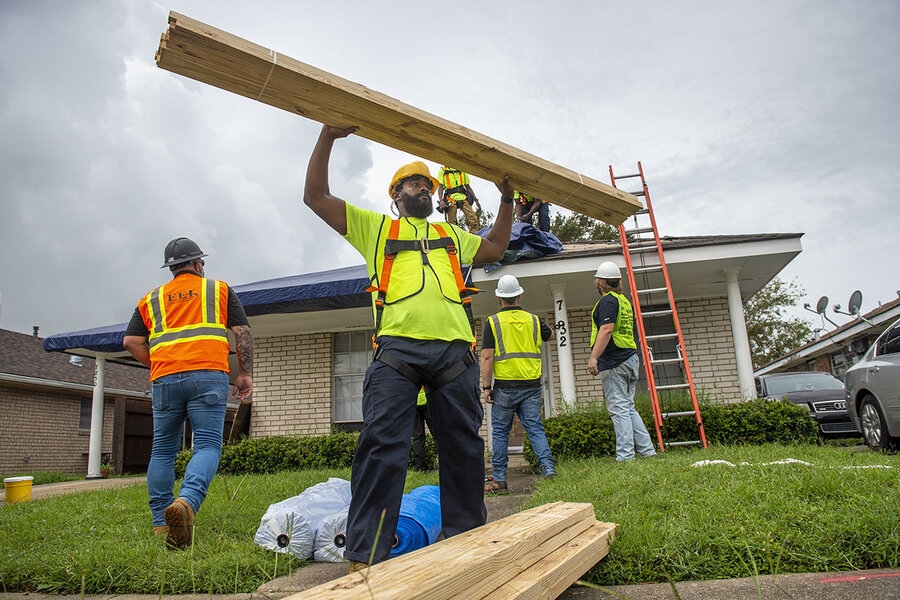A lesson from Hurricane Ida that is changing the world
Loading...
The stories of individual resilience in the wake of Hurricane Ida have been well told – neighbor helping neighbor, heroism from responders, and support from across the nation. But the story of a new, collective resilience needs to be told, too.
Ida has been covered as an example and a warning of the rising violence of climate change. And that’s an important context. But here’s another: Even as climate events become more dangerously frequent and potent, human societies have actually become safer – dramatically safer. By one measure, climate-related events killed 130 times more people worldwide in the 1920s than today.
Why We Wrote This
A story focused onWe know the power of individual resilience in the face of difficulty. But Hurricane Ida revealed how New Orleans has become more resilient collectively. It’s a more common story than you might think.
New Orleans shows why. Katrina killed more than 1,800 people. The breaching of the levees put 80% of the city underwater and was nearly an existential threat to New Orleans. But after Ida struck last month, the now-fortified levees held.
Only big, complex teams – directed through the institutions we’ve developed over centuries – can achieve what New Orleans accomplished in the past 16 years. Individual learning can be a flashlight for families, communities, organizations, nations. But it is collective learning, what we achieve together, that changes the world.
In the weeks since Hurricane Ida landed at New Orleans, it has illustrated two very different stories. One is the rising violence of the changing climate. The other, which is only now fully emerging, is the human resilience that has already made the world far safer.
New storms are already forming in the Gulf of Mexico, but the aftermath of Hurricane Ida is now entering what we might call the resilience zone. It can be the most testing, and telling, phase.
As part of the Monitor’s Finding Resilience project, here is a tale of two cities: The New Orleans hit by Hurricane Katrina 16 years ago and the New Orleans hit by Hurricane Ida late last month.
Why We Wrote This
A story focused onWe know the power of individual resilience in the face of difficulty. But Hurricane Ida revealed how New Orleans has become more resilient collectively. It’s a more common story than you might think.
They were not identical storms. Ida struck with less sweeping girth than Katrina but more sheer force. They weren’t all that different, either.
But they hit a different New Orleans. Katrina killed more than 1,800 people. The breaching of the levees put 80% of the city underwater. The blow was nearly existential to New Orleans as we knew it. Three in 10 residents vacated, many permanently.
After Ida struck last month, the now-fortified levees held against the surge. The toll in fatalities in Louisiana is at 28. A similar number died in New Jersey as Ida-driven rain flooded the Northeast. The scale of damage and heartbreak is so vastly different that clearly Louisiana is more robust and storm-hardy than in 2005. The population had even grown back in New Orleans, recently surpassing its pre-Katrina numbers.
The effects of human resilience
Ida has been covered as an example and a warning of the rising violence of climate change, making hurricanes stronger, floods higher, and fires bigger and more frequent in the dry West. And that’s an important context.
But here’s another: Even as climate events become more dangerously frequent and potent, humanity has actually become safer – dramatically safer.
The economist Bjorn Lomborg finds that the number of people killed worldwide by climate-related events in the 1920s, a century ago, was 27 times higher than the number killed over the decade ending 2019. Corrected for the far higher global population today, the death rate a century ago was more than 130 times what it is today.
Dr. Lomborg’s point is that when we assess the costs, the dangers, and the difficulties that climate change implies, human resilience and ingenuity is a nontrivial factor. So far, in fact, it has been an overwhelming factor.
A term like resilience can risk sounding a little minimizing and reductive – just a personal character trait. It is much more than that.
Those who have been through a hurricane strike report that it is after the winds have gone quiet, the ground dried, and the sun shining in steamy afternoons, only then have they arrived at the hard part – the exhausting building back, the forging ahead, the relaunch into forward motion.
Same goes for those facing the gray, weightless ash of the West’s massive wildfires, or Afghans recalculating their course after fundamentalist warlords swept back over their country, or Germans after July’s crushing floods, or Haitians struggling out from under a presidential assassination, a city-crushing earthquake, and a drenching tropical storm in the space of a single month.
It’s the months after that can take the real fortitude to push back against a grim exhaustion.
Many of the efforts to resuscitate post-Katrina New Orleans were deeply personal, with families making remarkable sacrifices to rebuild the economy and education, much less the roads, bridges, and buildings of the city itself.
So resilience is a matter of spirit, of finding the heart to come back. But its structure, the ladder resilience climbs, is learning. We pick ourselves up, we learn what we need to learn, and we get to work.
Aiming bigger
And it’s not just person-by-person resilience that drives the kind of change we have seen. It’s collective. Only big, complex teams can achieve what New Orleans accomplished in the past 16 years. The scale of the investment, the engineering, the overlapping interests, the cross-cutting visions and values – only politics can put all that together and sort all that out.
That’s counterintuitive in a time where politics is scorned as a divisive and inflammatory form of cultural theater, a little like professional wrestling but not as harmless.
Yet humankind has made the world, per Mr. Lomborg’s numbers, more than 99% safer against natural disasters in the last century by scaling resilience. And we do that through the institutions we use to work together.
The only way we can learn and then act on as massive a scale as demanded of New Orleans is through the institutions we’ve developed over centuries – whether it’s a city council, a police department, a university, an engineering association, a religious denomination, a news organization, a Supreme Court, or an updated building code.
It’s the lack of robust institutions that reduce resilience in a country like Haiti – where such institutions were undermined by Western powers for centuries – to a more individual matter. Anyone who has visited the nation has witnessed the sheer energy and unoppressed vitality of the people that crowd the streets of Port au Prince. The spirit is there, but it’s a resilience on foot, a personal challenge, and not yet a resilience that can collectively build safety from the next natural disaster.
Individual learning can be a flashlight for families, communities, organizations, nations. But it is collective learning, what we achieve together, that holds real power. In fact, civilization itself could be defined as collective learning.
That makes the resilience shown by New Orleans more than just a story of individual grit, but of what we, even in this raucously, ridiculously divided country, can do together.
Marshall Ingwerson is a former editor of the Monitor.









